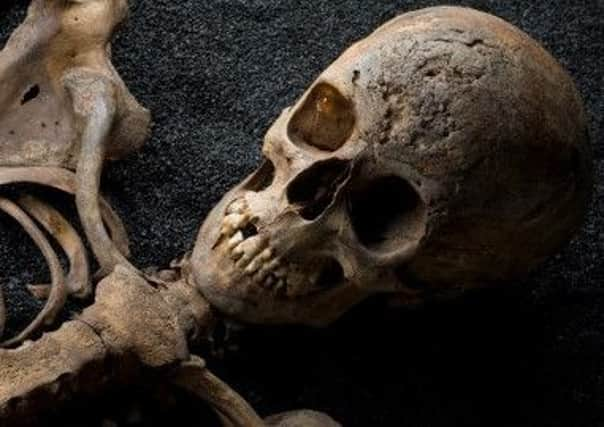Exhibition makes no bones about our grisly past


It features, for example, the (pictured) skeleton of a woman who died on Tiree in the Outer Hebrides around 5,000 years ago - the first time it has even been exhibited.
But it also features the bones of people, often young, who died in appalling circumkstances in the Middle Ages - prematurely old and riddled with disease.
Advertisement
Hide AdAdvertisement
Hide AdIronically one of the museum’s best-known permanent collections relates to the Antonine Wall, where research has uncovered evidence of what was, for the period, a relatively civilised existence for the auxilia soldiers manning the turf ramparts around what’s now Milngavie or Bearsden.
Their diet was surprisingly varied, they made full use of their bathhouse, and for the officer class there was even underfloor central heating.
Life on the wild Celtic frontier of what was to become East Dunbartonshire could probably end suddenly and painfully during times of war, and barracks life must have been tough, but modern forensic archaeology has shown that colonial auxiliaries from countries including Gaul (modern France), Spain and North Africa could have a surprisingly “cultured” existence, as compared with the desperate lives endured by the inhabitants of medieval London slums.
But disease has crippled and destroyed people down through the millennia, as shown by the remains of an adult Roman man who suffered from a type of blood cancer, and a medieval man who died from the Black Death - after first having apparently survived an arrowhead lodged in his spine.
Advertisement
Hide AdAdvertisement
Hide AdCalled “Skeletons: our buried bones” the joint exhibition with the Museum of London is a sometimes horrifying confirmation of the idea that life in the remote past could be nasty, brutish and short.
Professor David Gaimster, Director of The Hunterian, says of the neolithic Tiree skeleton: “She’s very well preserved, she was buried in the beach on Tiree, she suffered from congenital rickets, so she suffered from various episodes of malnutrition.
“There are lots of interesting theories such as why in this open landscape on the coast did she not get enough light - why was she covered up?
“We’re very delighted to bring this skeleton to the exhibition. It’s the first time it’s ever been exhibited and I would argue it is one of our greatest treasures.”
Advertisement
Hide AdAdvertisement
Hide AdThe Scottish collections also include a late Medieval skeleton, possibly a murder victim, unearthed from Perth’s Horse Cross cemetery and on loan from Perth Museum and Art Gallery.
The exhibition opened on Friday, is free, and runs until January 8.
There’s more about the Hunterian at www.gla.ac.uk/hunterian/